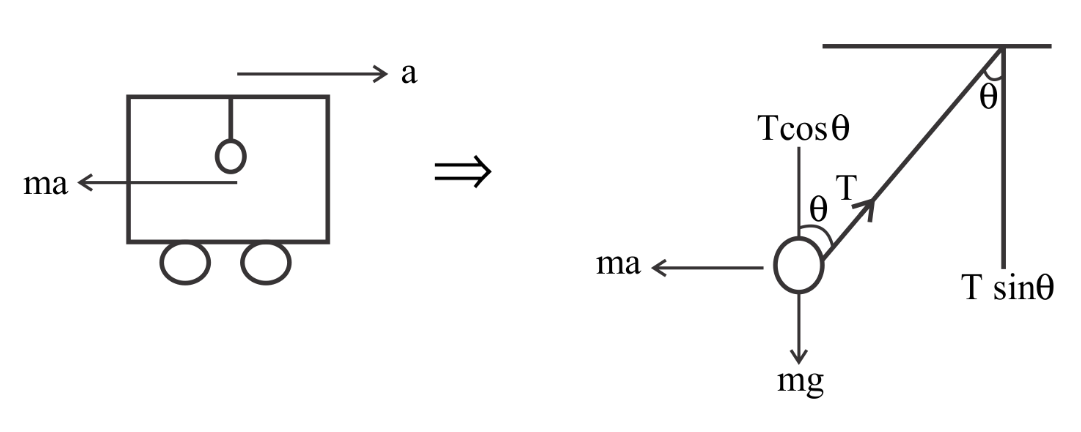
A simple pendulum is set up in a trolley that moves to the right with acceleration $a$ on a horizontal plane. Then the thread of the pendulum in the mean position makes an angle $\theta $ with the vertical.
$\left( A \right)$ ${\tan ^{ - 1}}\left( {\dfrac{a}{g}} \right)$ In the forward direction
$\left( B \right)$ ${\tan ^{ - 1}}\left( {\dfrac{a}{g}} \right)$In the backward direction
$\left( C \right)$ ${\tan ^{ - 1}}\left( {\dfrac{g}{a}} \right)$ In the backward direction
$\left( D \right)$ ${\tan ^{ - 1}}\left( {\dfrac{g}{a}} \right)$ In the forward direction
Answer
147k+ views
Hint: For solving this type of problem we should be able to know the first simple pendulum function and how the change in motion changes the string tension and everything. Motion, length, amplitude, mass are things that affect the swing of the pendulum.
Complete step by step solution Here in this question it is given that a trolley has an acceleration$a$. As this trolley moves, their frame of reference also changes. Also, it is given that it makes some angle with the vertical. Therefore now through all this information, we will now be able to solve this problem.

Now we will go in the frame of the trolley, so for this, we will have the following conditions
Also, there will be a pseudo force having $ma$ force in the opposite direction. This force will act when there is the ma force that is acting on the bob of the pendulum.
After a certain time the pendulum will make $\theta $ an angle from the mean position. So the new angle made by it will be as follows.
Tension on the string will be $T$ and the angles will be $T\cos \theta $ and $T\sin \theta $ as shown in the figure.
Due to gravity, there will be $mg$
Now balancing all four forces, we get
\[ \Rightarrow mg = T\cos \theta \]
And the other equation will be
$ \Rightarrow ma = T\sin \theta $
Now on dividing both the above equations, we get
$ \Rightarrow \dfrac{a}{g} = \tan \theta $
Hence $\theta = {\tan ^{ - 1}}\left( {\dfrac{a}{g}} \right)$
So the answer will be $\theta = {\tan ^{ - 1}}\left( {\dfrac{a}{g}} \right)$in a backward direction.
Note: A setup could be a straightforward device composed of a weight suspended on a string, wire, metal, or different material that swings back and forth. Pendulums are utilized in gramps clocks and also they prefer to keep time.
Complete step by step solution Here in this question it is given that a trolley has an acceleration$a$. As this trolley moves, their frame of reference also changes. Also, it is given that it makes some angle with the vertical. Therefore now through all this information, we will now be able to solve this problem.

Now we will go in the frame of the trolley, so for this, we will have the following conditions
Also, there will be a pseudo force having $ma$ force in the opposite direction. This force will act when there is the ma force that is acting on the bob of the pendulum.
After a certain time the pendulum will make $\theta $ an angle from the mean position. So the new angle made by it will be as follows.
Tension on the string will be $T$ and the angles will be $T\cos \theta $ and $T\sin \theta $ as shown in the figure.
Due to gravity, there will be $mg$
Now balancing all four forces, we get
\[ \Rightarrow mg = T\cos \theta \]
And the other equation will be
$ \Rightarrow ma = T\sin \theta $
Now on dividing both the above equations, we get
$ \Rightarrow \dfrac{a}{g} = \tan \theta $
Hence $\theta = {\tan ^{ - 1}}\left( {\dfrac{a}{g}} \right)$
So the answer will be $\theta = {\tan ^{ - 1}}\left( {\dfrac{a}{g}} \right)$in a backward direction.
Note: A setup could be a straightforward device composed of a weight suspended on a string, wire, metal, or different material that swings back and forth. Pendulums are utilized in gramps clocks and also they prefer to keep time.
Recently Updated Pages
How to find Oxidation Number - Important Concepts for JEE

How Electromagnetic Waves are Formed - Important Concepts for JEE

Electrical Resistance - Important Concepts and Tips for JEE

Average Atomic Mass - Important Concepts and Tips for JEE

Chemical Equation - Important Concepts and Tips for JEE

Concept of CP and CV of Gas - Important Concepts and Tips for JEE

Trending doubts
JEE Main 2025 Session 2: Application Form (Out), Exam Dates (Released), Eligibility, & More

JEE Main Exam Marking Scheme: Detailed Breakdown of Marks and Negative Marking

JEE Main 2025: Derivation of Equation of Trajectory in Physics

Electric Field Due to Uniformly Charged Ring for JEE Main 2025 - Formula and Derivation

JEE Main Participating Colleges 2024 - A Complete List of Top Colleges

Degree of Dissociation and Its Formula With Solved Example for JEE

Other Pages
JEE Advanced Marks vs Ranks 2025: Understanding Category-wise Qualifying Marks and Previous Year Cut-offs

JEE Advanced 2025: Dates, Registration, Syllabus, Eligibility Criteria and More

Units and Measurements Class 11 Notes: CBSE Physics Chapter 1

NCERT Solutions for Class 11 Physics Chapter 1 Units and Measurements

Motion in a Straight Line Class 11 Notes: CBSE Physics Chapter 2

JEE Advanced Weightage 2025 Chapter-Wise for Physics, Maths and Chemistry




